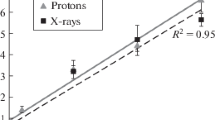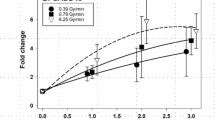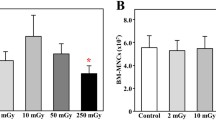The proportion of splenocytes with a high level of DNA double-strand breaks was determined in mice exposed to primary and secondary radiation created by bombarding of a concrete barrier (thickness 20, 40, and 80 cm) by 650 MeV protons. The proportion of splenocytes with a high level of DNA double-strand breaks was assessed by flow cytometric analysis of γH2AX+ and TUNEL+ cells. It is shown that concrete barrier can significantly reduce primary proton radiation; the severity of negative biological effects in mice irradiated in the center of the proton beam decreased with increasing the thickness of this barrier. However, the spectrum of secondary radiation changes significantly with increasing the barrier thickness from 20 to 80 cm and the distance from central axis of the beam from 0 to 20 cm, and the proportion of the neutron component increases, which also causes negative biological effects manifesting in a significant (p<0.05) increase in the percentage of splenocytes with a high level of DNA damage in mice irradiated at a distance of 20 cm from the center of the proton beam and receiving relatively low doses (0.10-0.17 Gy).
Similar content being viewed by others
References
Horst F, Boscolo D, Durante M, Luoni F, Schuy C, Weber U. Thick shielding against galactic cosmic radiation: A Monte Carlo study with focus on the role of secondary neutrons. Life Sci. Space Res. (Amst). 2022;33:58-68. https://doi.org/10.1016/j.lssr.2022.03.003
Woolf N, Angel R. Pantheon habitat made from regolith, with a focusing solar reflector. Philos. Trans. A Math. Phys. Eng. Sci. 2021;379:20200142. https://doi.org/10.1098/rsta.2020.0142
Restier-Verlet J, El-Nachef L, Ferlazzo ML, Al-Choboq J, Granzotto A, Bouchet A, Foray N. Radiation on earth or in space: what does it change? Int. J. Mol. Sci. 2021;22(7):3739. https://doi.org/10.3390/ijms22073739
Ivanov AA, Krylov AR, Molokanov AG, Bushmanov AYu, Samoylov AS, Pavlik EE, Mytsin GV, Shvidky SV, Timoshenko GN. Modeling of laboratory animals exposure conditions behind local concrete shielding bombarded by 650-MeV protons. Med. Radiol. Radiat. Safety. 2021;65(5):77-86. https://doi.org/10.12737/1024-6177-2020-65-5-77-86
Cortese F, Klokov D, Osipov A, Stefaniak J, Moskalev A, Schastnaya J, Cantor C, Aliper A, Mamoshina P, Ushakov I, Sapetsky A, Vanhaelen Q, Alchinova I, Karganov M, Kovalchuk O, Wilkins R, Shtemberg A, Moreels M, Baatout S, Izumchenko E, de Magalhães JP, Artemov AV, Costes SV, Beheshti A, Mao XW, Pecaut MJ, Kaminskiy D, Ozerov IV, Scheibye-Knudsen M, Zhavoronkov A. Vive la radiorésistance!: converging research in radiobiology and biogerontology to enhance human radioresistance for deep space exploration and colonization. Oncotarget. 2018;9(18):14 692-14 722. https://doi.org/10.18632/oncotarget.24461
Babayan N, Grigoryan B, Khondkaryan L, Tadevosyan G, Sarkisyan N, Grigoryan R, Apresyan L, Aroutiounian R, Vorobyeva N, Pustovalova M, Grekhova A, Osipov AN. Laser-driven ultrashort pulsed electron beam radiation at doses of 0.5 and 1.0 Gy induces apoptosis in human fibroblasts. Int. J. Mol. Sci. 2019;20(20):5140. https://doi.org/10.3390/ijms20205140
Asaithamby A, Chen DJ. Cellular responses to DNA double-strand breaks after low-dose gamma-irradiation. Nucleic Acids Res. 2009;37(12):3912-3923. https://doi.org/10.1093/nar/gkp237
Costes SV, Chiolo I, Pluth JM, Barcellos-Hoff MH, Jakob B. Spatiotemporal characterization of ionizing radiation induced DNA damage foci and their relation to chromatin organization. Mutat. Res. 2010;704(1-3):78-87. https://doi.org/10.1016/j.mrrev.2009.12.006
Kotenko KV, Bushmanov AY, Ozerov IV, Guryev DV, Anchishkina NA, Smetanina NM, Arkhangelskaya EY, Vorobyeva NY, Osipov AN. Changes in the number of double-strand DNA breaks in Chinese hamster V79 cells exposed to γ-radiation with different dose rates. Int. J. Mol. Sci. 2013;14(7):13 719-13 726. https://doi.org/10.3390/ijms140713719
Babayan N, Vorobyeva N, Grigoryan B, Grekhova A, Pustovalova M, Rodneva S, Fedotov Y, Tsakanova G, Aroutiounian R, Osipov A. Low repair capacity of DNA double-strand breaks induced by laser-driven ultrashort electron beams in cancer cells. Int. J. Mol. Sci. 2020;21(24):9488. https://doi.org/10.3390/ijms21249488
Blokhinа TM, Yashkina EI, Belyaeva AG, Perevezentsev AA, Shtemberg AS, Osipov AN. Long-term persistence of increased number of γH2AX+ peripheral blood lymphocytes in monkeys exposed to negative factors of space flights: ionizing radiation and simulated hypogravity. Bull. Exp. Biol. Med. 2021;172(1):81-84. https://doi.org/10.1007/s10517-021-05336-8
Krenning L, van den Berg J, Medema RH. Life or death after a break: what determines the choice? Mol. Cell. 2019;76(2):346-358. https://doi.org/10.1016/j.molcel.2019.08.023
Vorobyeva NY, Babayan NS, Grigoryan BA, Sargsyan AA, Khondkaryan LG, Apresyan LS, Chigasova AK, Yashkina EI, Guryev DV, Rodneva SM, Tsishnatti AA, Fedotov YA, Arutyunyan RM, Osipov AN. Increased yield of residual γH2AX foci in p53-deficient human lung carcinoma cells exposed to subpicosecond beams of accelerated electrons. Bull. Exp. Biol. Med. 2022;172(6):756-759. https://doi.org/10.1007/s10517-022-05472-9
Bushmanov A, Vorobyeva N, Molodtsova D, Osipov AN. Utilization of DNA double-strand breaks for biodosimetry of ionizing radiation exposure. Environ. Advances. 2022;8. https://doi.org/10.1016/j.envadv.2022.100207
Osipov AN, Ryabchenko NI, Ivannik BP, Dzikovskaya LA, Ryabchenko VI, Kolomijtseva GYa. A prior administration of heavy metals reduces thymus lymphocyte DNA lesions and lipid peroxidation in gamma-irradiated mice. Journal de Physique IV: JP. 2003;107:987-992. https://doi.org/10.1051/jp4:20030464
Author information
Authors and Affiliations
Corresponding author
Additional information
Translated from Byulleten’ Eksperimental’noi Biologii i Meditsiny, Vol. 174, No. 8, pp. 154-159, August, 2022
Rights and permissions
Springer Nature or its licensor (e.g. a society or other partner) holds exclusive rights to this article under a publishing agreement with the author(s) or other rightsholder(s); author self-archiving of the accepted manuscript version of this article is solely governed by the terms of such publishing agreement and applicable law.
About this article
Cite this article
Blokhina, T.M., Ivanov, A.A., Vorobyeva, N.Y. et al. DNA Damage in Splenocytes of Mice Exposed to Secondary Radiation Created by 650 MeV Protons Bombarding a Concrete Shielding Barrier. Bull Exp Biol Med 174, 194–198 (2022). https://doi.org/10.1007/s10517-023-05672-x
Received:
Published:
Issue Date:
DOI: https://doi.org/10.1007/s10517-023-05672-x




